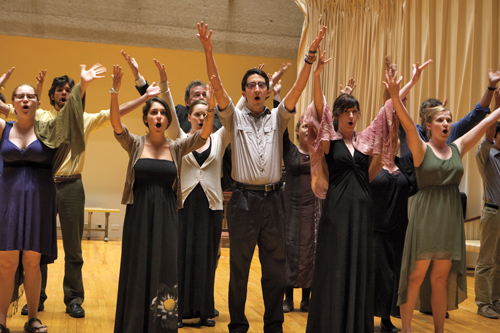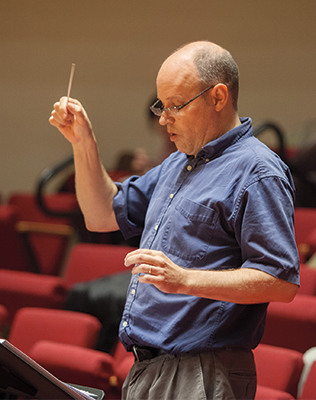A real-life execution is the focus of a professor’s new opera.
By Eric Goldscheider
Photos by Ilana Panich-Linsman
[Faculty] What makes for an operatic story? Murder and mayhem help, but just as important are simplicity and timelessness—“the kind of story that strikes an audience member as immediately familiar,” says composer Eric Sawyer, an associate professor of music at Amherst.
The Garden of Martyrs, a 2005 historical novel by Michael C. White, has all of those elements. It’s based on the true story of two Irish immigrants falsely accused, convicted and executed for a murder near Springfield, Mass., at a time when Catholics were a new and threatening presence to many New Englanders.
Sawyer’s latest project is an opera based on that novel. Created with librettist Harley Erdman, it premiered in September at the Academy of Music in Northampton, not a mile from the execution spot. The Springfield Symphony Orchestra and a coterie of professional directors, performers and designers provided the staging.

Performers at a rehearsal for the new opera Garden of Martyrs,
composed by Associate Professor of Music Eric Sawyer
The opera, like the book, is about Dominic Daley and James Halligan, who were hanged on June 5, 1806, in front of 15,000 eager onlookers. Many years later, modern forensics exonerated them. The other central character is Jean-Louis Lefebvre de Cheverus, a priest who ministered to the convicts in their final days. Cheverus was a refugee from horrific brutalities in the wake of the French Revolution.
Sawyer and Erdman pared down White’s story to the essential scenarios and characters. Then, as Erdman wrote the libretto, each character became imbued “with a way of speaking, certain rhythms, certain melodic inflections,” says Sawyer. “The words come first, and they are the wellspring of musical ideas.”
In the opera, Father Cheverus’ “final speech, where he faces a crowd of bloodthirsty people” on behalf of the prisoners, is a moment of “personal redemption,” says Sawyer. “The burden of survivors’ guilt” and a “dark secret from his past” plague Cheverus, who, in this telling, had compromised his principles to escape a massacre of priests in France.
The Garden of Martyrs is Sawyer’s second opera. (His first is about the assassination of Abraham Lincoln.) He hopes this new work stimulates discussion on a “story that repeats itself in America of newcomers who are treated with suspicion when something goes wrong.” Today, he argues, Daley and Halligan would be branded as terrorists.

Sawyer conducts during a pre-premiere rehearsal in Buckley Recital Hall.
While the libretto makes no explicit connection to the present, it “reminds us of the danger of biases and prejudices,” Erdman says—“of the destructive force of jumping to conclusions.”
White consciously excluded himself from the opera’s creative process, and when he heard Sawyer’s music for the first time, he says, he “felt chills” at how it conveyed “the suffering and the feelings of my characters.” Watching the opera take shape was “almost like having a child,” White says. “I was seeing what came from me originally, but it was made into something wholly new.”